
Giant Reign Advanced Review
Isn’t it great when everything falls into place? When the bike brand you are most drawn to makes a bike that lights you up, all is well in the world. Giant hasn’t been that brand for me. Aside from their racing heritage, I know little about those behind the brand. Giant’s founder, King Liu, wasn’t a cyclist when he founded the Taiwanese company in 1972, although he became one later. The perception is that Giant has less soul than some other companies that make mountain bikes, but that hasn’t stopped them from making some excellent, if somewhat uninspiring, mountain bikes in the past.
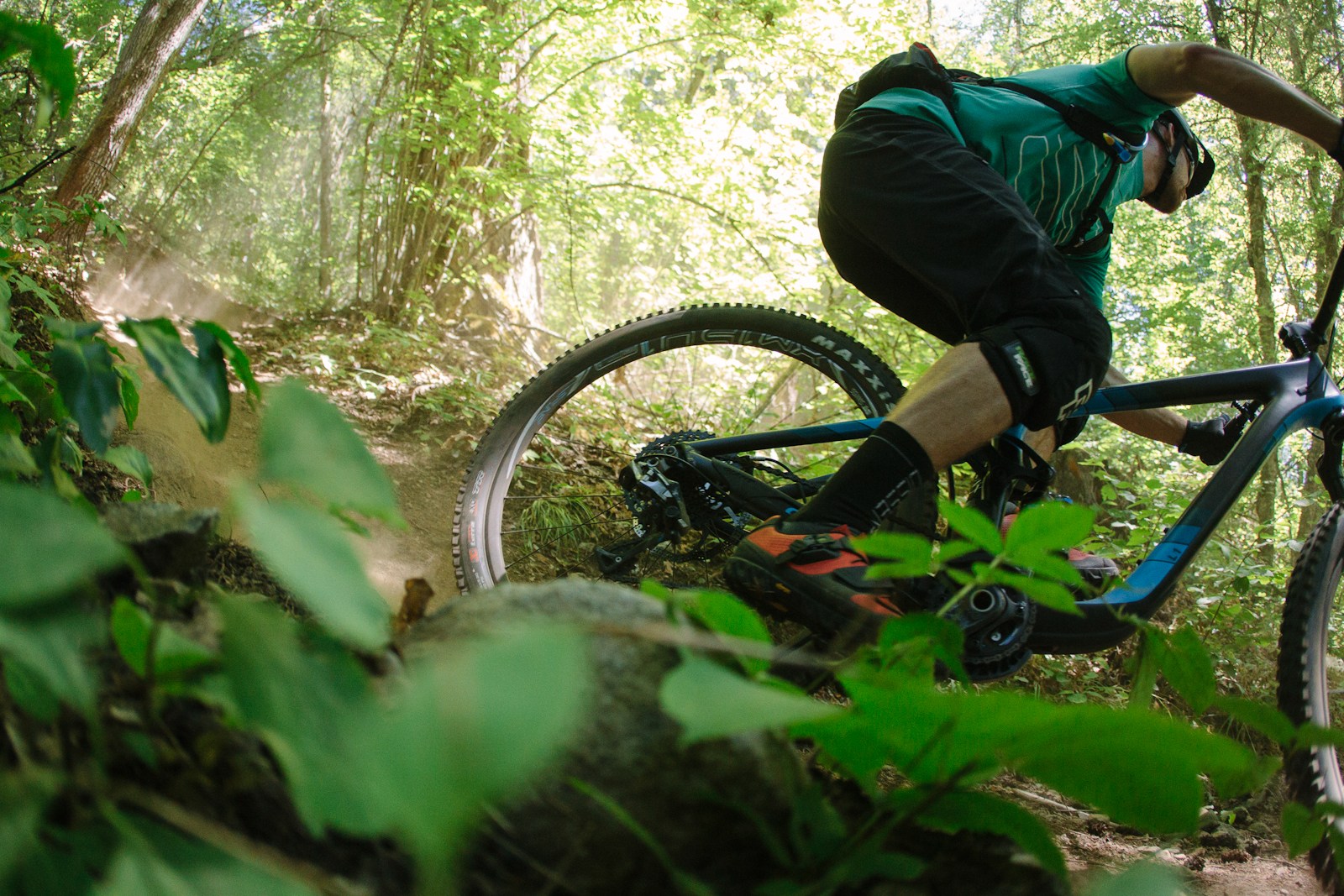
It took something like 200 meters to feel comfortable on the Reign. Maybe 150. Rider: Pete Roggeman. Photo: Sterling Lorence.
Slowly the brand has started to match function with form however, and the 2015 Reign along with other current models look fantastic. Is that a sign of some soul? Has the influence of the staff, racers and sponsored riders finally injected the character that some of us feel has been missing from the largest bike company in the world?
You can find Pete’s article, written after the press launch in Pemberton last July, here.

In the last year we heard a lot of “long, low, and slack” but nothing we rode was quite as LLS as the Giant Reign Advanced. And that’s why it felt so good in the steep, rough, or fast. Photo: Sterling Lorence.
Both of us have been riding the bike on and off since that time and my initial rides were around Whistler during Crankworx. The bike was easy to get centred on and, aside from a stubbornly sticky front rotor, I took to it right away. We rode Gargamel, most of the EWS course (not in one day like the EWS crew) as well as some laps in the bike park – and I was surprised by how capable the bike is. We dropped in to Top Of The World after Jared Graves began his winning run and I noted a suppleness that surprised me. After hundreds of racers had bolted down the trail it was beaten down, but – like a Honey Badger – the Reign didn’t mind.
Another surprise was how lively the bike felt while absorbing significant impacts with ease. There are times when the Reign advanced feels like a trophy truck to me – it absorbs a drop without any bounce or recoil and returns to the sweet spot in the travel smoothly, allowing you to be ready for whatever comes next almost immediately. At the same time the Reign gets off the ground like it’s spring loaded. It provides excellent damping when needed, combined with more support than you might expect when the bike is preloaded to get over something or for a drop.

During the Reign’s development, Giant’s product team requested different fork rake options from SRAM to get the trail dialed in. It worked out.
As a climber I have few complaints about the Reign. With a short stem and a 780mm bar I have no trouble negotiating switchbacks despite the 65 degree head angle. For extended climbs I tend to engage the platform mode in the Monarch Debonair rear shock for a little more support. Riding the Yeti SB6c I never felt the need to flip the shock into climb mode but the Reign benefitted from some extra compression. Traction on technical climbs is good but, again comparing to the Yeti SB6c, I found the rear end somewhat less active. At just over 28 lbs for our size large, there’s not a lot of heft to push, and I never shied away from a big effort on the Reign.
Singletrack is where the Reign rules. I particularly grooved on this bike when things opened up and I found myself doubling things I hadn’t considered before. The controlled travel front and rear gives me confidence to let things hang out. It also excels in the corners, changing directions easily and digging in well.
In steep rough sections I’ve learned to let the bike roll. I can get off the brakes without compromising control because the wheels stay in good contact, allowing me to steer and maneuver the bike rather than white knuckling the brakes.
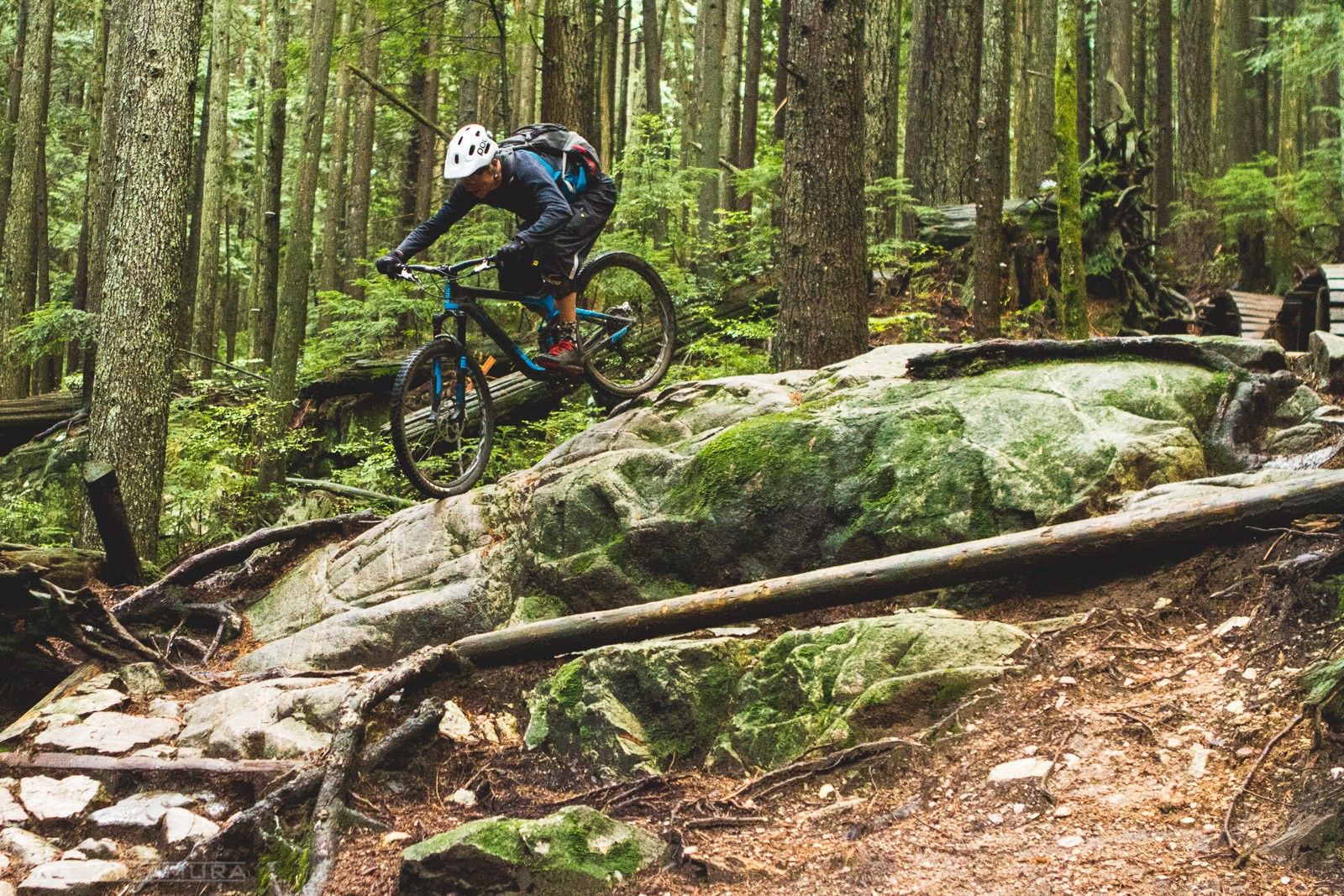
Cam tackling some of the rockery of Ladies Only. the long cockpit matched with a short stem made for a roomy cockpit and excellent handling. Photo – Kaz Yamamura
Some bikes only handle well when your nose is ahead of your handlebar but there have been times when I’ve ridden this bike from the back seat without feeling compromised. When I unweight the front end exiting a corner the bike seems to accelerate.
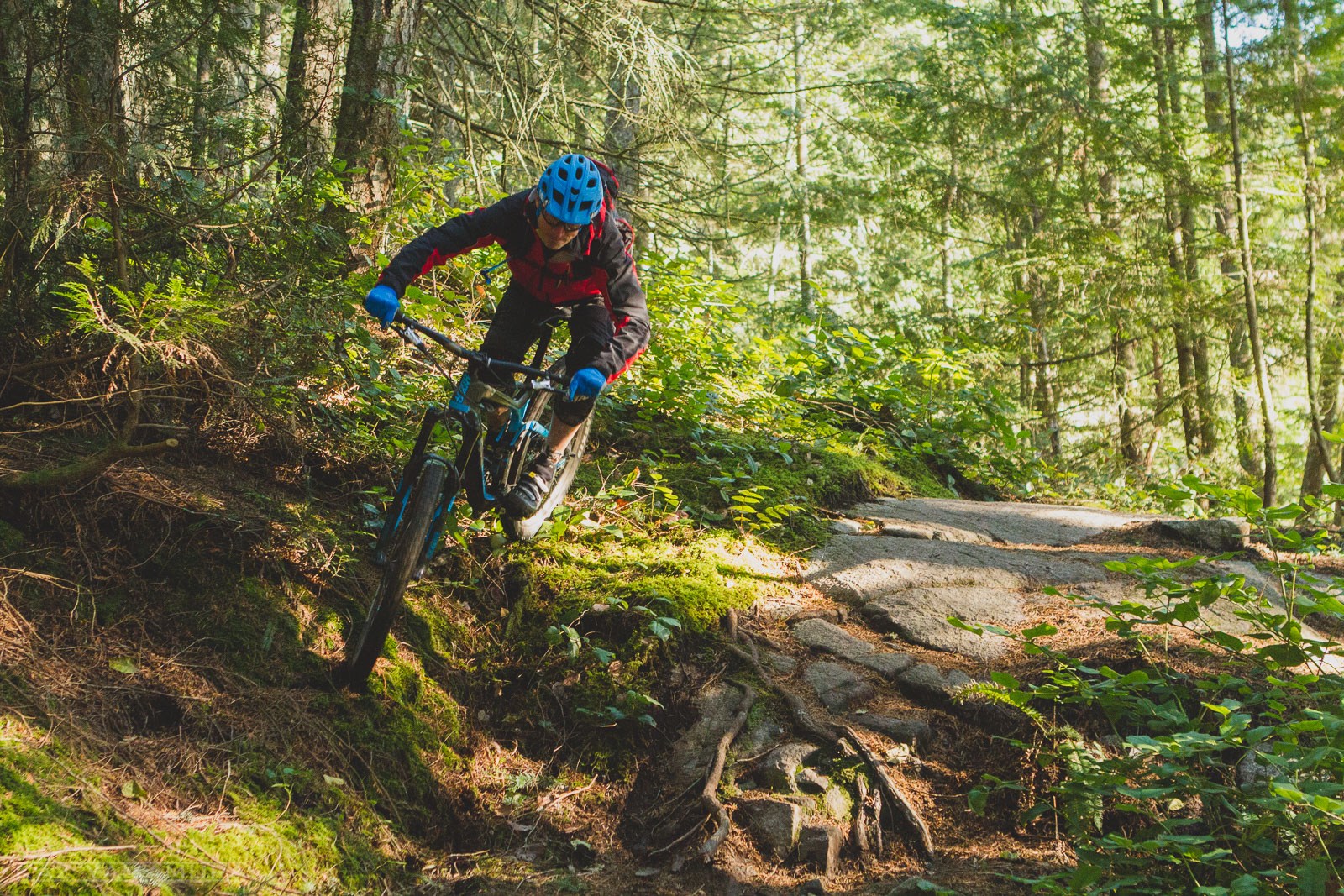
The Reign encourages creative line choice. Cam goes wide on Tall Cans trail on Cypress Mountain. Note – this is not a Strava line. Photo – Kaz Yamamura
I’m a big fan of the Rock Shox Pike up front but I’ve spent less time on the Rock Shox Monarch Plus RC3 DebonAir. It works incredibly well with the Maestro floating pivot suspension platform. Small bump sensitivity is a perfect compromise between bump absorption and trail feel for me, but some riders may want the more rigid top end provided by a bike with more linear rear travel. The Giant is supple quite deep into the travel but it ramps up well in response to larger impacts.
My overarching impression of the Reign is that it allows me to be calm in the face of challenging trail conditions. Knowing the bike responds so well allows me choose new lines, pop off obstacles and ride faster. I am indeed smitten.
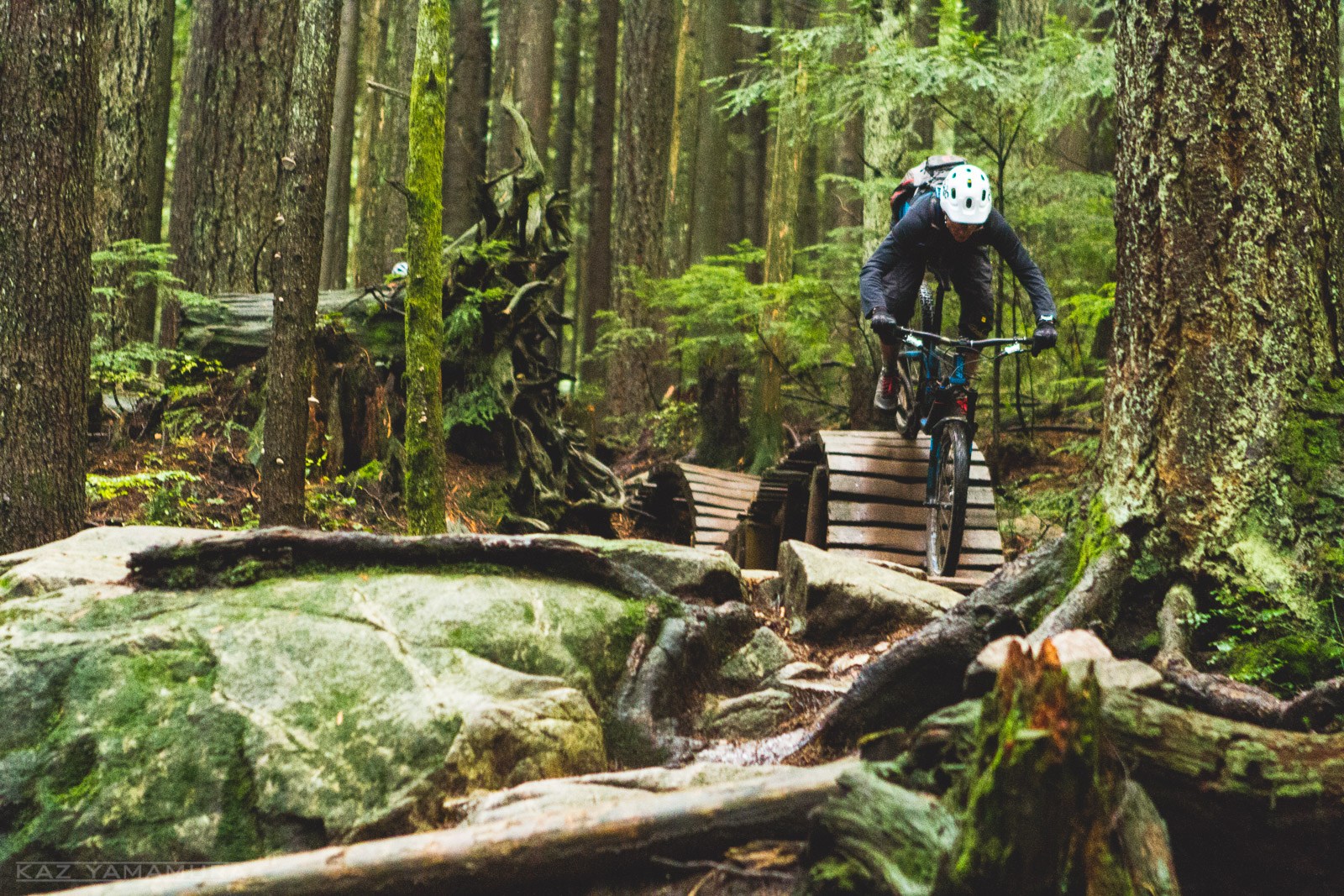
Woodwork is becoming scarce on the Shore – but it’s there if you know where to look. Rider – Cam McRae. Photo – Kaz Yamamura
Spec-wise I haven’t wanted to change anything. The bike we’ve been riding came with Avid XO Trail brakes, but the production bike will have Guide RSCs installed. That said the XO Trail, despite Avid’s recent fall from public grace, have never failed to impress me.
The XX1 drivetrain was flawless except for the time I lost my chain in a tumble. This is to be expected but the MRP AMG chain guide made replacing the chain a challenge. Not being much of a racer I would remove this for day to day use.
Our tires weren’t to spec either and rather than the Schwalbe Magic Mary front, Hans Dampf rear combo our tester came with Maxxis High Rollers front and rear. We’ve ridden the bike enough that some of the side knobs are missing, but the tires were otherwise just right.

In your local bike shop you’ll find a Schwalbe Magic Mary up front, a Hans Dampf and SRAM Guide brakes. Our early production model was spec’ed a little differently.
Seb Kemp spent some time on the bike and he felt the DT Swiss 1501 wheels flexed more than he liked. While my riding abilities didn’t tax the rigidity of the hoops nearly as much, there were times when the steering precision provided by burlier wheels would have been welcome.
I didn’t even change the grips. In fact I really liked the Giant-branded lock ons. It’s very rare for me to not change a single part on a stock bike but nothing was broke so I didn’t fix it.
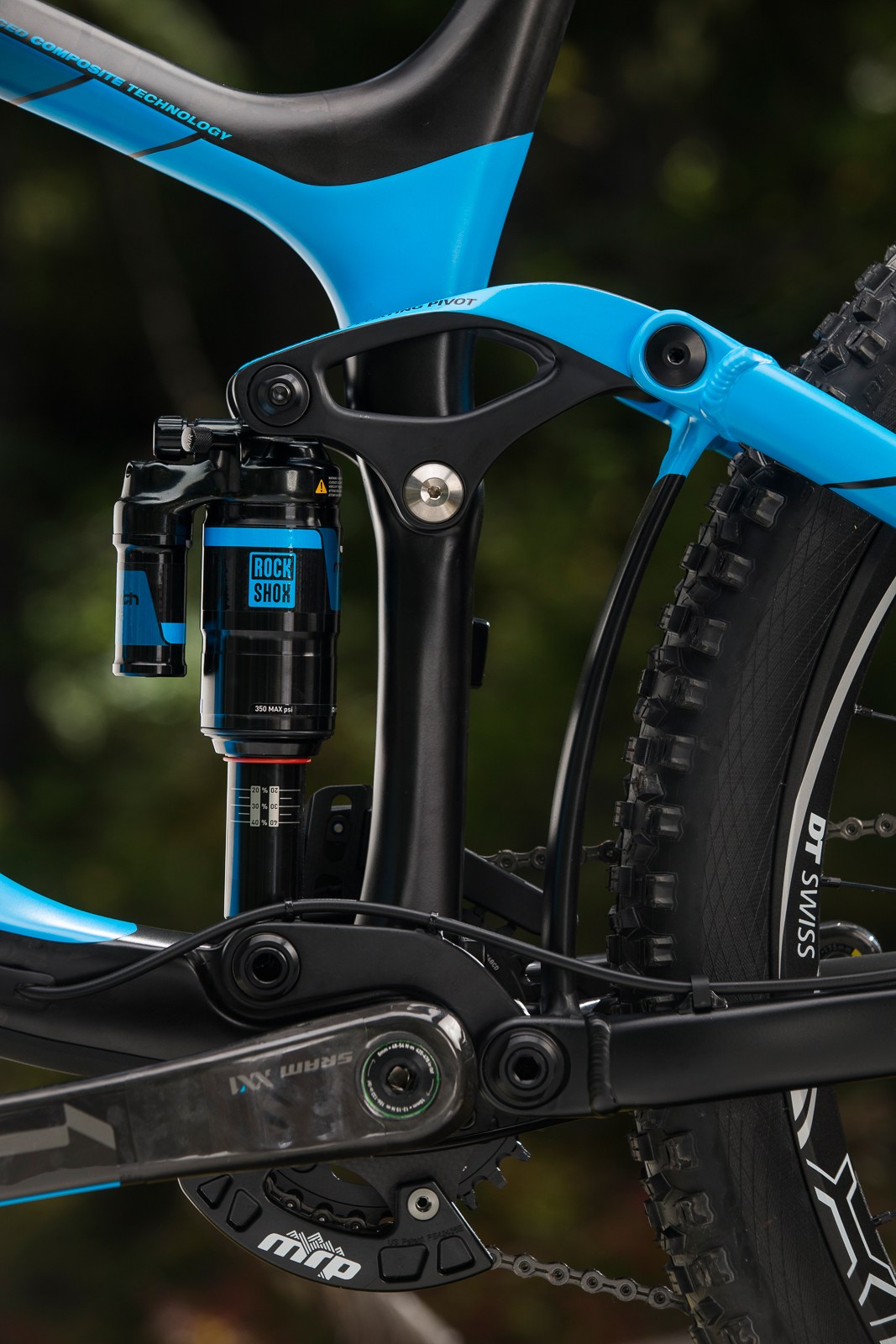
The colour-matched Rock Shox Monarch Plus DebonAir RC3 was plush and supple while still providing excellent support to keep the handling spirited. You’ll appreciate the chainguide if there is some Enduro racing in your future.
A bike this good can’t be made by a soulless corporate entity. The details are nailed, the spec is perfection but the real win is the way the Reign rides. You can’t be schooled on a mountain bike trail by the founder of Giant like you can with the owners of Yeti, Ibis, Santa Cruz and even Specialized, but those behind the Reign have given the Scarecrow what he was after.

The heli drop saw us chase each other down scrubby alpine and floaty singletrack, and try to stave off arm pump through rough and sustained sidehill lines for several kilometers at a time. It was enough to convince me that the Reign was a very worthy choice for gravity-fed rides even if that included a fair amount of climbing.

Looking at the numbers, the Giant’s size L is the lowest, longest (TT and Wheelbase), and tied for slackest. The ride is stable and confidence-inspiring, but it doesn’t seem to give up much liveliness. It’s an addictive combination.
The Giant Reign is available in two Advanced (carbon) and two Alloy models. Those prices aren’t typos – identically spec’d Reign and Reign Advanced models cost less in Canada than the US. With today’s US dollar about 15% stronger than the Loonie, that makes for significant savings North of the border. Also note that the Reign Advanced 1 comes with the same carbon front/alloy rear frame as the Advanced 0 Team, the same Pike RCT3 Dual Position Air and the same Monarch Plus RC3 DebonAir – that is outstanding value at $4199 CAD and likely where a few of us would choose to spend our money.
Reign Advanced 0 Team: $8250 USD / $7499 CAD – this was the bike we tested.
Reign Advanced 1: $4750 USD / $4199 CAD
Reign 1: $5975 USD / $5299 CAD
Reign 2: $3400 USD / $2849 CAD
The new Reign hasn’t received as much attention as it deserves but now that they’re hitting shop floors, we expect to see a lot of them around.











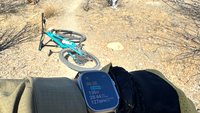
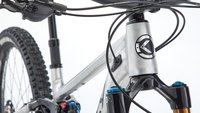
Comments
Morne
9 years, 3 months ago
so how about a three bike shoot out? The yeti the giant and the nomad. They share so much in common but I have not been able to find a head to head comparo.
Reply
DW
9 years, 3 months ago
Is the MSRP actually cheaper in Canada or is it the other way around?
Reply
Cam McRae
9 years, 3 months ago
From the article:
The Giant Reign is available in two Advanced (carbon) and two Alloy models. Those prices aren’t typos – identically spec’d Reign and Reign Advanced models cost less in Canada than the US. With today’s US dollar about 15% stronger than the Loonie, that makes for significant savings North of the border. Also note that the Reign Advanced 1 comes with the same carbon front/alloy rear frame as the Advanced 0 Team, the same Pike RCT3 Dual Position Air and the same Monarch Plus RC3 DebonAir – that is outstanding value at $4199 CAD and likely where a few of us would choose to spend our money.
Reign Advanced 0 Team: $8250 USD / $7499 CAD – this was the bike we tested.
Reign Advanced 1: $4750 USD / $4199 CAD
Reign 1: $5975 USD / $5299 CAD
Reign 2: $3400 USD / $2849 CAD
Reply
Poo Stance
9 years, 3 months ago
Looking at the pricing is Giant trying to befriend the Canadian bike consumer?
8250USD/7500CDN Reign A0
7100USD/8100CDN for a Range 7.1
6600USD/8400CDN Nomad X01
8400USD/9100CDN Slash 9.9
You'd think a certain company would do the same with their pricing…
I'd park my money on the Giant
Reply
soren
9 years, 3 months ago
also to be fair to all these bikes it should be noted that many companys; Santa Cruz, Giant and idk how many others, are posting their effective seat tube angles messured through the center of bottom bracket and seat collar rather than the TRUE seat angle which is measured at the actual angle that the seat post is from horizontal. i measured the new nomad having been stoked on the idea of a 74.5 degree seat angle and come to find it is actually 70.5 degrees. its misinformation, unfair and slimey. my 07 nomad has a steeper seat angle yet all these manufactures are touting their steep seat tube angles.
Reply
Cr4w
9 years, 3 months ago
Are you mixing up Effective Seat Tube Angle with Actual Seat Tube Angle? Because most companies list both.
Reply
soren
9 years, 3 months ago
i would define the "actual seat tube angle" as the angle of the seat post.
theangle of the seat post is far more relevant of a measurement seeing as
our seat posts regularly extend 7 or more inches from the top of our
seat tube, which is higher than the horizontal or "effective" top tube
measurement.
As someone who has been shopping for a new mountain bike that is notably more capable burly and spry than my v1 nomad and having thoroughly digested most major manufactures geometry charts and frame designs it is my impression that far to many of these manufactures provide incomplete, unclear, deceptive geometry charts. some are missing reach, actual top tube length, bottom bracket height, axle to crown and tire size that bb hight was measured with or weather the seat tube angle or top tube length is actual or effective. they really should all have a model visual model that corilates directly to the numbers.
here is why i feel that it is an important differentiation. i will start by saying I dont like to waste my time squabling about stuff but i feel that it is quite relevant to a bike that is meant to pedal well. this is because when a slack seat post angle (calling it that for claritys sake) is employed it provides much more leverage that weights the rear wheel causing the bike to want to wheelie or apply to much weight to the rear wheel which may stick it in holes unless you make massive body movments to transfer weight forward mid climb. Even more important is body position which is relevant to our ability to make power, when that seat gets too far behind the bottom bracket it really starts to detract from our body's ability to make power. also for handlng i for one i wanna be up on it in the center of the bike when im hammering a technical climb trying to maneuver and mountain goat up shit, not struggling to keep my body weight balanced over and worrying about my rear wheel hanging up .
Reply
Avner B.
9 years, 3 months ago
Don't you move the saddle on its rails to get optimal body position regardless of the seat tube angle?
Reply
soren
9 years, 3 months ago
the reign advanced one actually comes with the pike rc dual position air
rather than the rct3. having ridden both i actually prefer the large
low speed compression knob of the rc, and the lack of a lock out on the
fork, which is pointless unless your a squid.
Reply
james
9 years, 3 months ago
the trail looks incredible. how long would it take to climb to that peak where the chopper dropped you, if accessible at all?
Reply
t.odd
9 years, 3 months ago
many multiples of hours….probably wouldn't be the most fun thing in the world, it's way up there and pretty remote…unless you just want to do the classic Tenquille descent from lake to valley
Reply
Pudskies
9 years, 3 months ago
Did you guys have an opinion on the dual position feature of the pike? Other reviewers have stated that it is useless due to the fact that it is too soft when in the lower travel setting.
Also wondering how you guys have measured the BB height? Every article has had a different measurement so far that I have seen, including your introductary article on this bike, despite the fact that all the bikes have had the same tires equipt.
Reply
Pete Roggeman
9 years, 3 months ago
Never descended with it in 130 mode (why would you?) and never honestly felt the need to use it for climbing, either. The travel adjustable fork remains a love it or hate it issue for people, and for me it is something I would only ever use on long climbs (45+ mins). It might provide a bit of extra maneuverability for technical climb sections, but we didn't feel the Reign suffered enough to warrant its use.
Reply
soren
9 years, 3 months ago
uhh durr
1 because some trails are tighter and lower speed than a 65 degree head angle is ideal for
2 because it steepens the seat tube angle (benifits of steep seat tube stated above)
3 because when your torso is less acute to your legs your lungs can expand better
are you a mountain biker or a writer pete?
Reply
soren
9 years, 3 months ago
this may be a bit of a consperacy theory but the benifits of travel adjust forks are blatantly obvious.
i believe that the only reason that someone would not want to employ one is because the bike they are riding has a bottom bracket height that is so low that it is daunting to think of loosing any more crank arm clearance for the sake of clearing thechnical climbs.
i understand why some may call them unnneciisary
1 because they suck up to manufacures who produce bikes with bottom bracket hieghts that are rediculusly low to be considered an "all mountain bike"
2 because they or the other softies in the mountain bike community dont have the gumption to take attacking and cleaning technical climbs seriously and are happy to give up and walk their bike up the hill like school girls on beach cruisers.
Reply
Pete Roggeman
9 years, 3 months ago
You're certainly welcome to your opinion, Soren. And you sure have a lot of them.
Reply
JD
9 years, 3 months ago
I don't need to steepen my angles to clean technical sections, so I'd prefer to reap the rewards of the low bottom bracket, and the simpler, suppler fork. Pretty simple.
Reply
Cam McRae
9 years, 3 months ago
I never use travel adjust despite owning two bikes with that feature. I take attacking and cleaning technical climbs seriously and I'm not bad at it either.
Reply
Cam McRae
9 years, 3 months ago
Really Soren? Descending in 130 mode? Perhaps you read that wrong. On the trails this bike is designed for that would never be advantageous.
And Pete is both a writer and rider.
Reply
Pudskies
9 years, 2 months ago
Was the press fit BB ever a problem on the Reign? I only ask because I have never had a frame that required a press fit BB and there is a lot of hate for them. I have heard that if they are installed with a bit of loctite there is no issue.
For the record though, I didn't mean that I would attempt descending in 130 mode. I was asking due to the review on pinkbike that mentioned the pike is too soft in 130 mode while climbing to make it useful. I haven't used a travel adjust fork, and I would consider spending the extra cash for the advanced 1 to have the option to use it, although I might anyway to have the upgraded component spec and rear shock.
Reply
Pete Roggeman
9 years, 2 months ago
No press fit BB issues in our time with it so far. If I could choose, I would favour threaded, but that doesn't mean press fit is bad - they're just more prone to issues.
Re: the travel adjust, I didn't know if you meant one or the other (climb or descend) so I addressed both. Don't consider spending a bunch of extra money for that feature, is my advice, but there are a lot of other spec upgrades between the two that make it worthwhile.
I haven't seen the PB review but if you're climbing with the fork in 130, your weight is also being pulled forward a bit more due to the steeper head angle, so that might account for a bit of a softer feeling for a given sag setup. With bikes in this category, climbing performance is still important but not nearly as important as the way the bike rides when doing what it was designed primarily to do, which is kick ass on the way down.
Reply
wydopen
9 years, 3 months ago
The Pinkbike review you were referring to was way off base. The Pike Dual Position has the rtc3 so you just put it in the middle setting when you lower the fork for climbing. I dont think there is any performance given up by the travel adjust…it's not like an older talas fork. I love my dual position on my bike with a 65deg HA but I do allot of climbing on it..
Reply
Longrider
9 years, 3 months ago
How does the Reign stack up against last years Trance Advanced SX that you reviewed?
Reply
t.odd
9 years, 3 months ago
as I wrote the SX review, and haven't ridden the new Reign, I am unable to comment.
Reply
Noah Sears
9 years, 3 months ago
Surely you don't think the AMg guide caused your chain to come off? Seems a but unfair to suggest taking it off after suggesting you had just one chain drop during the whole test - which happened in a crash.
Reply
fdsa
9 years, 3 months ago
I think he is saying the opposite. No need for chain guide because chain retention is so good.
Reply
Pete Roggeman
9 years, 3 months ago
I'm speaking for Cam here, but what he meant was that the chain guide made it difficult to get the chain back ON.
For my part the inclusion of the chain guide is a bit of a head scratcher. It adds weight and cost, and many/most buyers don't need it, since only the most aggressive descenders will be able to shake a chain off a narrow/wide ring + clutch derailleur setup. In my opinion it would have been better to leave it off, saving the average buyer some money. Racers or other riders who feel they need a guide can add one later.
Reply
Noah Sears
9 years, 3 months ago
I guess. But by that logic these people don't need an enduro race bike either. A bigger head scratcher to me is when extremely capable bikes aren't spec'd accordingly - leaving the end-user to immediately add to their brand new bike.
Reply
Cam McRae
9 years, 3 months ago
Hey Noah. As I said the chain came off because of a crash. I said nothing about the guide causing my chain to come off. That said - in the more than two years since I've been riding SRAM 1 by systems this is the first time I've lost a chain - and the guide actually slowed me down. Based on my experience thus far I'd forego a guide even if I was a racer.
Reply
wydopen
9 years, 3 months ago
Aside from chain retention the AMg also has a bash plate which will end up saving people money in the end when they don't destroy their narrow wide on a rock..Also I'd hope most people buying a bike like that are riding rough enough terrain to drop the chain. For fast riders a n/w + clutch doesn't do the job
Reply
wydopen
9 years, 3 months ago
I should say unless they are putting a brand new x-sync chainring and chain on every race..
Reply
Matt
9 years, 3 months ago
That depends entirely on the terrain you ride and the frame your ride it with.
Reply
asdf
9 years, 3 months ago
Good review. I will chime in to agree 100% with your take on it. I am running the stock tires and the Magic Mary is amazing. Like laughing-out-loud-amazing after holding on through corners on a line that I did not deserve to succeed through.
I am often confused when reviews talk about "climbing". Do you mean the bike's ability to scale a short tech climb, or overall time/energy to get to the top? Other reviews on this bike say it doesn't "climb" well due to "LLS". I don't want to get dropped on the ups to badly, but would not buy a bike to clean the occasional tech climb as a priority trait.
Reply
Cam McRae
9 years, 3 months ago
Perhaps I should have been more specific. For short tech climbs the Reign works well. I cleaned four sections on Wednesday that I don't always get. One of them is below 50% for sure so the bike was no handicap. As far as fireroad climbing, I find the Reign to be a little more active than the SB6c - which provides a very solid platform. As a result if I'm feeling sluggish I put the compression damping on the Monarch in the firmest position. I wouldn't hesitate to take this bike on an XC ride - but it wouldn't be my ride of choice for BC Bike Race. I wouldn't steer you away from this bike based on the way it climbs. It gets the job done just fine and I've never felt like it has held me back.
Reply
Doug Nielsen
9 years, 2 months ago
@Cam McRae- how would you compare the climbing to the Nomad-meaning-would you take the Nomad on the BC Bike Race? I'm doing Singletrack6 and was going to get a Nomad carbon. Just wanted your take.
Reply
Cam McRae
9 years, 2 months ago
Doug - if you are a supremely gifted climber who struggles going down that could make sense. You could firm up the suspension and put on some light tires - but it's going to be the wrong tool for the job. I would take a smaller and lighter bike for sure.
Could you do it? Sure you could. And it would probably be a blast.
Reply
Doug Nielsen
9 years, 2 months ago
I appreciate your reply! Ok then, one more question. In your humble opinion- the best tool for that job (BC/Singletrack6) is…. Drum roll…
Reply
Pete Roggeman
9 years, 2 months ago
There is no one 'best' bike, for that kind of racing or any other. But Cam hinted at something that more people should consider when buying a bike, no matter what kind of riding they're planning to do. Many people's natural tendency is to do things that favour their strengths, and in the case of bike- buying this would mean that someone who descends better than they climb might choose a bike that reflects that fact. And if you're riding for fun, there's nothing wrong with that, of course. However if you're racing, you should be working to improve your weaknesses, rather than further bolstering your strengths.
So if you climb well or have strong fitness relative to your competitors, but are not as fast on the way down, it might be an idea to buy something that will augment your descending and help you make up a bit of time (or lose less than normal). Ditto if you're a strong technical rider - let those skills work for you but buy a bike that pedals well and has a faster/lighter build. You'll be faster overall, and whether your goal is the podium or finishing every day with enough energy to enjoy some post-riding yoga and a few beers, augmenting your weaknesses will go further towards helping you achieve it.
Reply
Please log in to leave a comment.